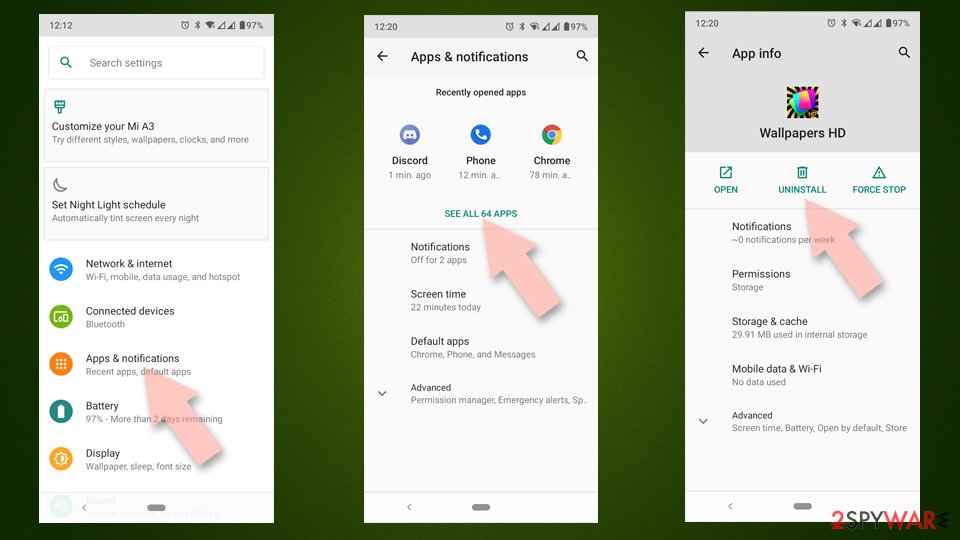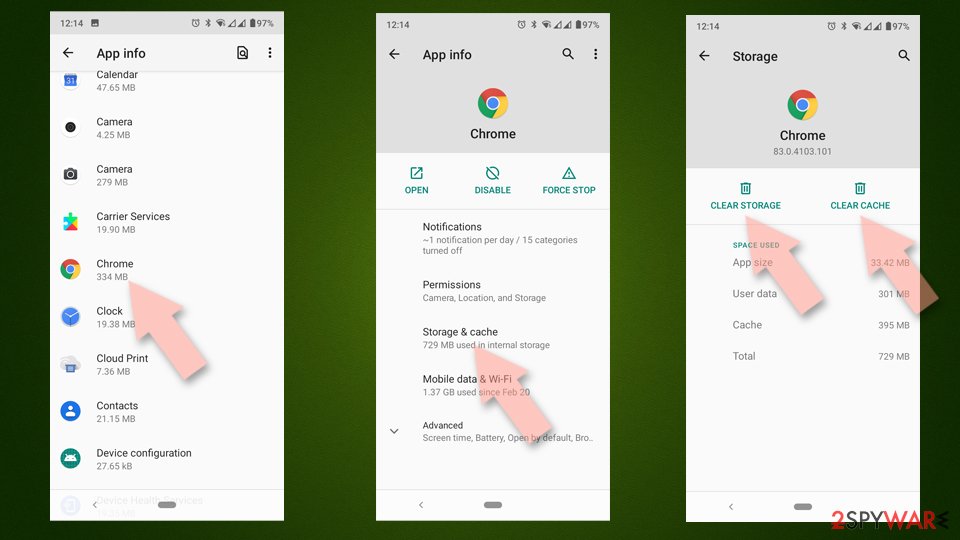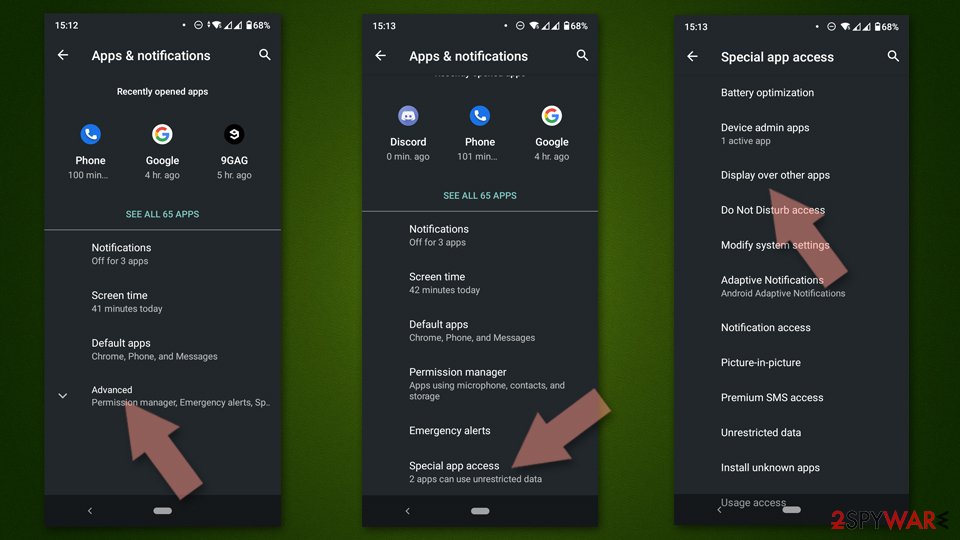Doombrand.xyz ads (Tutorial) - Chrome, Firefox, IE, Edge
Doombrand.xyz ads Removal Guide
What is Doombrand.xyz ads?
Doombrand.xyz is a malicious website that that lures users to subscribe to its notifications
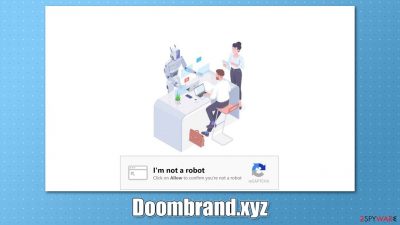
If you have started seeing Doombrand.xyz ads showing up on your screen, you must have allowed notifications to be shown from the website. These pop-ups usually cover all the other apps or windows and are shown either at the top-right or bottom right of the desktop. If you are using a phone or a tablet, these notifications will show up even if the device is idle and will come on top of the background. Likewise, this problem can occur regardless of which browser you are using, be it Google Chrome, Mozilla Firefox, MS Edge, or Safari, as all of them employ the push notification feature.
Doombrand.xyz operates a scam that is very common on the world wide web. In most cases, users come to this site inadvertently, usually after clicking a link on a deceptive or malicious website or due to adware[1] running in the background and causing browser redirects.
As soon as users get onto the website, they are presented with two distinct elements, which, in fact, are the only ones present on the page, as they are enough to fulfill the function they have been made for – to trick users. The components include a prompt that asks whether users would like to enable notifications from the site and a background picture/message which encourages visitors to do so. In fact, “encouraging” is the wrong word to use, as it's mostly straight-out lies and should be treated as such.
Nonetheless, there are plenty of ways how crooks can present the push notification feature as something completely different, thanks to the social engineering[2] tricks. Here are a few examples of messages you could come across after accessing the Doombrand.xyz website:
- Press “Allow” to watch the video
- Click Allow if you are not a robot
- Click “Allow” to close this window
- Your download is ready! Click Allow, etc.
These messages might make people believe that the purpose of the “Allow” button is to watch a video or proceed to allegedly view the content. However, this is nothing but a scam – there is no video to watch and no other content to explore. Instead, users would likely be redirected to other similar websites, such as Gettingyourcontent.com, Shotvideoalt.ru, or CleverCaptcha.top, which would ask for the same things.
Thus, don't even bother clicking the “Block” button, and simply leave the page. If you have been a victim of this scam, you shouldn't worry much, and remove the unwanted push notifications via web browser settings. We explain how below.
| Name | Doombrand.xyz |
|---|---|
| Type | Push notifications, pop-ups, ads, scam |
| Distribution | At some point after the push notifications are permitted by pressing the “Allow” button within the site's prompt |
| Symptoms | You may start seeing intrusive pop-ups on your desktop – clicking these may lead to insecure or even malicious websites |
| Risks | Ads and links to sites displayed by the website might be dangerous: users might suffer from monetary losses, install malware or potentially unwanted programs on their systems, or disclose their sensitive data to cybercrooks |
| Elimination | Access the settings of your browser and remove the permission for the site to deliver you notifications – more details are below. Also, check your system for infections with SpyHunter 5Combo Cleaner security software |
| Further steps | It is important to clean your browsers after removing potentially unwanted programs from your system – use FortectIntego to do it automatically |
There are thousands of websites that try to abuse the push notification feature for malicious purposes. Despite this, the element was not created having that in mind but rather as a tool that could help users reach relevant information immediately, which also benefits the service providers in many ways.
Initially, it was created by Apple back in 2009, and it was not until 2015 that the most popular web browsers adopted this feature. While you might have noticed that many websites nowadays ask for notifications to be enabled, they do it in a way that is understandable and not confusing.
At the same time, crooks use fake messages and misleading statements in order to make people subscribe. Unlike legitimate websites, however, Doombrand.xyz developers would send information that can be considered dubious at best.
For example, users might receive an offer to earn thousands of dollars within just a few days, all for a small investment. These are known as get-rich-quick schemes and are a very popular form of fraud online. There could also be statements about computer health or virus infections, and links would lead to websites that ask to download an alleged malware removal tool.
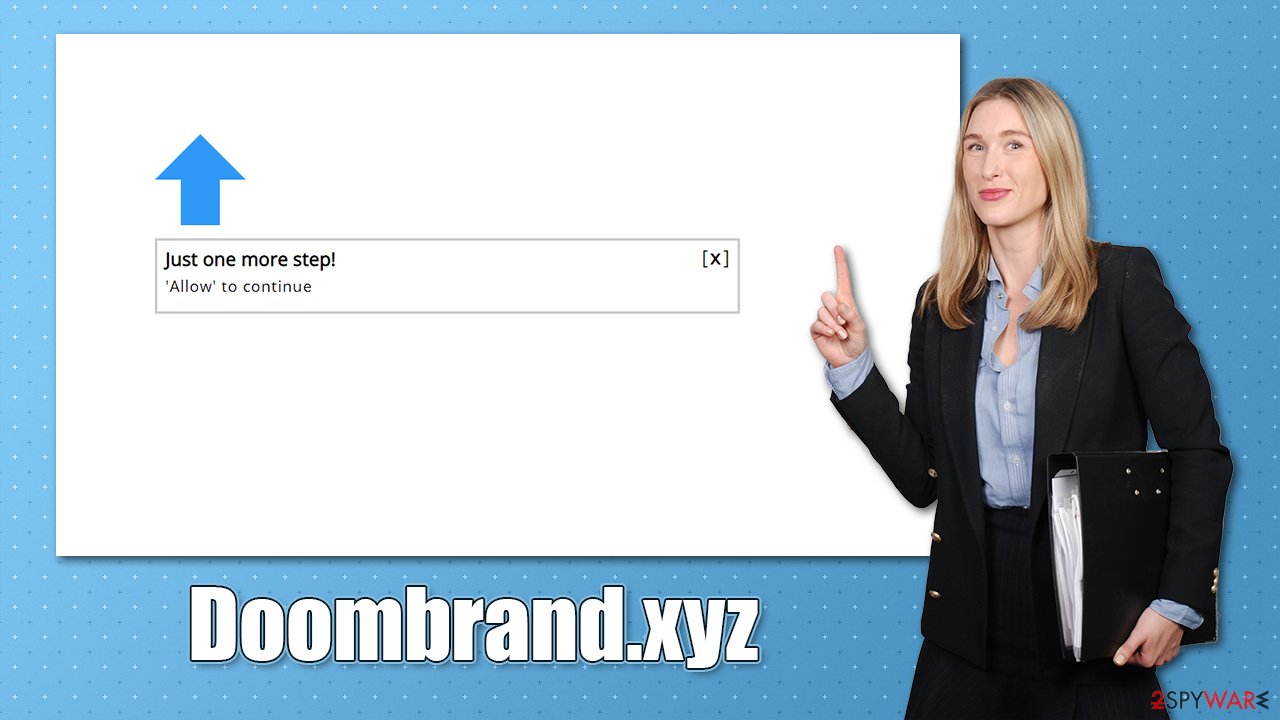
Please stay away from statements which claim your device is infected because websites simply can't know this information. They could read certain details about you, though, e.g., your IP address,[3] browser language, or the operating system used. This is completely normal, and you shouldn't worry about this – all of these messages are fake.
Below you will find details on how to remove the unwanted push notifications for good. Additionally, we provide guidelines on how to check the system for infections after that.
How to remove Doombrand.xyz ads
Many users are tricked into subscribing to push notifications from a malicious website thanks to misleading messages; in some cases, users might even click the “Allow” button by accident. The result is always the same – at some point after the request to show notifications is accepted, the site would send pop-ups on a regular basis, disturbing all the work being done on the computer at the time. Not only is it annoying, but it can also be dangerous if the links are clicked.
Therefore, it is vital to perform Doombrand.xyz removal as soon as possible. For that, you need to access the settings section of your browser and remove the permission to show send you notifications.
Google Chrome (desktop):
- Open Google Chrome browser and go to Menu > Settings.
- Scroll down and click on Advanced.
- Locate the Privacy and security section and pick Site Settings > Notifications.
- Look at the Allow section and look for a suspicious URL.
- Click the three vertical dots next to it and pick Block. This should remove unwanted notifications from Google Chrome.
![Stop notifications on Chrome PC 2 Stop notifications on Chrome PC 2]()
Google Chrome (Android)
- Open Google Chrome and tap on Settings (three vertical dots).
- Select Notifications.
- Scroll down to the Sites section.
- Locate the unwanted URL and toggle the button to the left (Off setting).
![Stop notifications on Chrome Android Stop notifications on Chrome Android]()
Mozilla Firefox:
- Open Mozilla Firefox and go to Menu > Options.
- Click on Privacy & Security section.
- Under Permissions, you should be able to see Notifications. Click the Settings button next to it.
- In the Settings – Notification Permissions window, click on the drop-down menu by the URL in question.
- Select Block and then click on Save Changes. This should remove unwanted notifications from Mozilla Firefox.
![Stop notifications on Mozilla Firefox 2 Stop notifications on Mozilla Firefox 2]()
MS Edge (Chromium):
- Open Microsoft Edge, and go to Settings.
- Select Site permissions.
- Go to Notifications on the right.
- Under Allow, you will find the unwanted entry.
- Click on More actions and select Block.
![Stop notifications on Edge Chromium Stop notifications on Edge Chromium]()
MS Edge (legacy):
- Open Microsoft Edge, and click the Settings and more button (three horizontal dots) at the top-right of the window.
- Select Settings and then go to Advanced.
- Under Website permissions, pick Manage permissions and select the URL in question.
- Toggle the switch to the left to turn notifications off on Microsoft Edge.
![Stop notifications on Edge 2 Stop notifications on Edge 2]()
Safari:
- Click on Safari > Preferences…
- Go to the Websites tab and, under General, select Notifications.
- Select the web address in question, click the drop-down menu and select Deny.
![Stop notifications on Safari Stop notifications on Safari]()
How to take care of adware or malware
While the intrusive pop-up notifications have nothing to do with adware or malware directly, there could be a connection still. Adware especially is a type of software that specializes in advertisements that show up in various forms; in some cases, it could also cause browser redirects. Therefore, if you encounter malicious websites frequently and the websites you open are filled with ads, you should definitely perform some checks.
Potentially unwanted programs and even malware are spread using deceptive distribution tactics such as software bundling, where several apps are compiled into a single installation wizard. Once opened, the window does not directly show all the programs to be installed and instead hides this fact using pre-ticked boxes, fine print, or promoting the usage of Recommended/Quick settings.
Thus, many people don't even know that they have adware installed on their computers, especially those who often download freeware from third-party websites. To prevent this, you should always download software from legitimate sources and pay close attention during the installation process.
To get rid of PUP, you can check the manual guide below or use SpyHunter 5Combo Cleaner, Malwarebytes as an automatic solution. Security software can also check your device for malware and remove all the malicious files at once. However, if the damage were done to your system files, it would not be able to repair it, so use FortectIntego for that if required. Likewise, the app can be used to clean web browsers after adware infection to prevent tracking and other issues. If you rather do this manually, check for details below.
Getting rid of Doombrand.xyz ads. Follow these steps
Uninstall from Windows
Instructions for Windows 10/8 machines:
- Enter Control Panel into Windows search box and hit Enter or click on the search result.
- Under Programs, select Uninstall a program.

- From the list, find the entry of the suspicious program.
- Right-click on the application and select Uninstall.
- If User Account Control shows up, click Yes.
- Wait till uninstallation process is complete and click OK.

If you are Windows 7/XP user, proceed with the following instructions:
- Click on Windows Start > Control Panel located on the right pane (if you are Windows XP user, click on Add/Remove Programs).
- In Control Panel, select Programs > Uninstall a program.

- Pick the unwanted application by clicking on it once.
- At the top, click Uninstall/Change.
- In the confirmation prompt, pick Yes.
- Click OK once the removal process is finished.
Delete from macOS
Remove items from Applications folder:
- From the menu bar, select Go > Applications.
- In the Applications folder, look for all related entries.
- Click on the app and drag it to Trash (or right-click and pick Move to Trash)

To fully remove an unwanted app, you need to access Application Support, LaunchAgents, and LaunchDaemons folders and delete relevant files:
- Select Go > Go to Folder.
- Enter /Library/Application Support and click Go or press Enter.
- In the Application Support folder, look for any dubious entries and then delete them.
- Now enter /Library/LaunchAgents and /Library/LaunchDaemons folders the same way and terminate all the related .plist files.

Uninstall from Android
Uninstall unwanted programs from Android device:
- Go to Settings -> Apps/Applications.
- Expand the full list of the installed apps.
- Scroll through the list and tap on a suspicious application once.
- Tap on it and select Uninstall.

- Reboot the device.
Clear Storage and data files on Android from Google Chrome or other apps:
- Go to Settings > Apps/Applications.
- Expand the full list of the installed apps.
- Tap on Chrome and select Storage & cache.
- Clear storage and clear cache of the app.

If you are seeing ads on top of other apps but are not sure what is causing it, perform the following steps:
- Go to Apps/Applications.
- Tap Advanced.
- Select Special App access.
- Tap on Display over other apps.

- Eliminate apps with these access rights enabled.
Remove from Google Chrome
Delete malicious extensions from Google Chrome:
- Open Google Chrome, click on the Menu (three vertical dots at the top-right corner) and select More tools > Extensions.
- In the newly opened window, you will see all the installed extensions. Uninstall all the suspicious plugins that might be related to the unwanted program by clicking Remove.

Clear cache and web data from Chrome:
- Click on Menu and pick Settings.
- Under Privacy and security, select Clear browsing data.
- Select Browsing history, Cookies and other site data, as well as Cached images and files.
- Click Clear data.

Change your homepage:
- Click menu and choose Settings.
- Look for a suspicious site in the On startup section.
- Click on Open a specific or set of pages and click on three dots to find the Remove option.
Reset Google Chrome:
If the previous methods did not help you, reset Google Chrome to eliminate all the unwanted components:
- Click on Menu and select Settings.
- In the Settings, scroll down and click Advanced.
- Scroll down and locate Reset and clean up section.
- Now click Restore settings to their original defaults.
- Confirm with Reset settings.

Remove from Microsoft Edge
Delete unwanted extensions from MS Edge:
- Select Menu (three horizontal dots at the top-right of the browser window) and pick Extensions.
- From the list, pick the extension and click on the Gear icon.
- Click on Uninstall at the bottom.

Clear cookies and other browser data:
- Click on the Menu (three horizontal dots at the top-right of the browser window) and select Privacy & security.
- Under Clear browsing data, pick Choose what to clear.
- Select everything (apart from passwords, although you might want to include Media licenses as well, if applicable) and click on Clear.

Restore new tab and homepage settings:
- Click the menu icon and choose Settings.
- Then find On startup section.
- Click Disable if you found any suspicious domain.
Reset MS Edge if the above steps did not work:
- Press on Ctrl + Shift + Esc to open Task Manager.
- Click on More details arrow at the bottom of the window.
- Select Details tab.
- Now scroll down and locate every entry with Microsoft Edge name in it. Right-click on each of them and select End Task to stop MS Edge from running.

If this solution failed to help you, you need to use an advanced Edge reset method. Note that you need to backup your data before proceeding.
- Find the following folder on your computer: C:\\Users\\%username%\\AppData\\Local\\Packages\\Microsoft.MicrosoftEdge_8wekyb3d8bbwe.
- Press Ctrl + A on your keyboard to select all folders.
- Right-click on them and pick Delete

- Now right-click on the Start button and pick Windows PowerShell (Admin).
- When the new window opens, copy and paste the following command, and then press Enter:
Get-AppXPackage -AllUsers -Name Microsoft.MicrosoftEdge | Foreach {Add-AppxPackage -DisableDevelopmentMode -Register “$($_.InstallLocation)\\AppXManifest.xml” -Verbose

Instructions for Chromium-based Edge
Delete extensions from MS Edge (Chromium):
- Open Edge and click select Settings > Extensions.
- Delete unwanted extensions by clicking Remove.

Clear cache and site data:
- Click on Menu and go to Settings.
- Select Privacy, search and services.
- Under Clear browsing data, pick Choose what to clear.
- Under Time range, pick All time.
- Select Clear now.

Reset Chromium-based MS Edge:
- Click on Menu and select Settings.
- On the left side, pick Reset settings.
- Select Restore settings to their default values.
- Confirm with Reset.

Remove from Mozilla Firefox (FF)
Remove dangerous extensions:
- Open Mozilla Firefox browser and click on the Menu (three horizontal lines at the top-right of the window).
- Select Add-ons.
- In here, select unwanted plugin and click Remove.

Reset the homepage:
- Click three horizontal lines at the top right corner to open the menu.
- Choose Options.
- Under Home options, enter your preferred site that will open every time you newly open the Mozilla Firefox.
Clear cookies and site data:
- Click Menu and pick Settings.
- Go to Privacy & Security section.
- Scroll down to locate Cookies and Site Data.
- Click on Clear Data…
- Select Cookies and Site Data, as well as Cached Web Content and press Clear.

Reset Mozilla Firefox
If clearing the browser as explained above did not help, reset Mozilla Firefox:
- Open Mozilla Firefox browser and click the Menu.
- Go to Help and then choose Troubleshooting Information.

- Under Give Firefox a tune up section, click on Refresh Firefox…
- Once the pop-up shows up, confirm the action by pressing on Refresh Firefox.

Delete from Safari
Remove unwanted extensions from Safari:
- Click Safari > Preferences…
- In the new window, pick Extensions.
- Select the unwanted extension and select Uninstall.

Clear cookies and other website data from Safari:
- Click Safari > Clear History…
- From the drop-down menu under Clear, pick all history.
- Confirm with Clear History.

Reset Safari if the above-mentioned steps did not help you:
- Click Safari > Preferences…
- Go to Advanced tab.
- Tick the Show Develop menu in menu bar.
- From the menu bar, click Develop, and then select Empty Caches.

How to prevent from getting adware
Access your website securely from any location
When you work on the domain, site, blog, or different project that requires constant management, content creation, or coding, you may need to connect to the server and content management service more often. The best solution for creating a tighter network could be a dedicated/fixed IP address.
If you make your IP address static and set to your device, you can connect to the CMS from any location and do not create any additional issues for the server or network manager that needs to monitor connections and activities. VPN software providers like Private Internet Access can help you with such settings and offer the option to control the online reputation and manage projects easily from any part of the world.
Recover files after data-affecting malware attacks
While much of the data can be accidentally deleted due to various reasons, malware is one of the main culprits that can cause loss of pictures, documents, videos, and other important files. More serious malware infections lead to significant data loss when your documents, system files, and images get encrypted. In particular, ransomware is is a type of malware that focuses on such functions, so your files become useless without an ability to access them.
Even though there is little to no possibility to recover after file-locking threats, some applications have features for data recovery in the system. In some cases, Data Recovery Pro can also help to recover at least some portion of your data after data-locking virus infection or general cyber infection.
- ^ What Is Adware?. Norton. Security blog.
- ^ Social Engineering. Imperva. Security solutions.
- ^ IP address From Wikipedia, the free encyclopedia. Wikipedia. The free encyclopedia.











